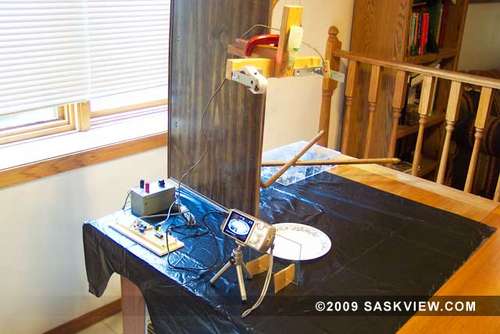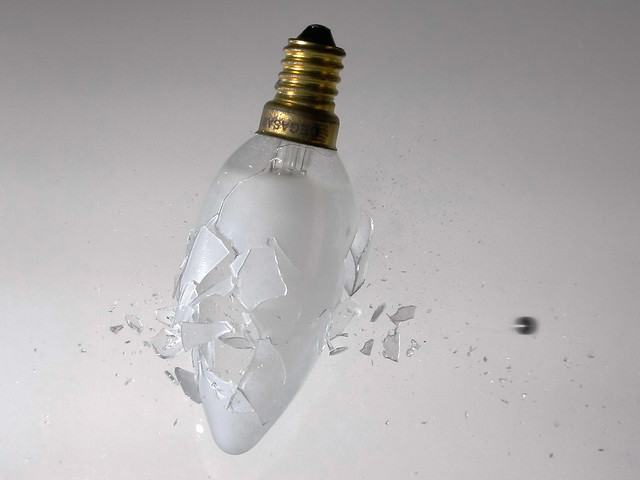High Speed Photography Using Laser Triggers
One of the fun capabilities that the CHDK hack for Canon point and shoot cameras enables is super fast shutter photography. By snapping the shutter at 1/10,000th of a second (or faster), you can freeze moments that are imperceptible to the human eye. Speeding bullets, balloons popping, or one of the more common shots, splashing water.
Once you have a camera that can stop time, you need a way to tell it exactly when you want to do so. Instructables users SaskView has created an awesome solution to that problem by building a laser trigger that causes the shutter to actuate when the beam of light is broken. What’s more impressive is that he’s sourced most of his parts from a 99 cent store – this is truly a lost cost/high return project.

Laser Triggered High-Speed Photography – More DIY How To Projects
Materials
I got the following at my local Dollar store (each item was actually $1.25: talk about misleading advertising!) Laser pointer Door chime USB Cable Magnets Clamp Shelf brackets Mini-tripod Self-Adhesive backed Velcro Small picture frame (for the plate glass insert) Eye drops (for the dropper bottle. I poured out the contents as I believe anything purchased at a dollar s…The Camera
You’ll need a Canon camera because we’re going to temporarily modify its firmware using the Canon Hacking Development Kit. CHDK is loaded onto the memory card inside the camera, allowing us to override most of the camera’s functions, turning a cheap point and shoot into a highly adjustable way-cool time freezer.Currently there are 47 Canon cameras that CHDK will work wi…The Circuit
At the bottom you’ll see a link to a pdf containing the schematic. To trigger your CHDK enabled camera we’ll be using the USB remote function. In this case we have to use it via the ‘syncable’ method, which is lightning fast compared to the normal USB remote. The syncable remote also operates differently. It triggers the camera on the falling edge instead of the risin…The Laser
The laser pointer has a momentary switch but I wanted a slide switch that would allow the laser to remain on without me holding the button. The Dollar store magnetic door chime not only had the slide switch that I wanted, but also it used the same kind and number of batteries that the laser does. This was cheaper than buying just a switch from an electronics supplier. …The Drop Rig
Below is a photo of my setup. Some pieces of wood and some steel shelf brackets clamped to a TV tray. The laser is mounted with the magnets on one of the brackets, and the photodiode on the other. In between and slightly above I’ve velcro’d the eye dropper bottle filled with milk.CHDK Settings: Enabling Synchable Remote
In order for the USB cable remote to work, you have to enable it. With CHDK installed on your camera go into the Main Menu and at the very bottom you’ll see Miscellaneous stuff. Enter that menu and at the very bottom of it you’ll find the Remote parameters menu. In that menu set Enable Remote [.] Make sure there is a dot inside the square brackets, meaning it’s enable…CHDK Settings: Extra Photo Operations
Now go into the Extra Photo Operations menu at the top of the main menu and set: Disable Overrides [disable] Include AutoIso & Bracketi [.] Override shutter speed [1/10000] Value factor [1] Shutterspeed emun type [Ev Step] Override aperture [5.03] Override Subj. Dist. V [350] Value factor [1] Override ISO value [80] Value factor [1] Force manual flash [.] Power of flas…Adjusting the Camera Settings
Normally you would be triggering an external flash, while the shutter is open using a cable release with the camera in ‘bulb’ mode. Once the flash goes off, you let the shutter close. This requires the room to be darken because the shutter will be open for many seconds. In this setup you can have the room lights on because the flash and shutter are triggered at the sam…Adjusting the circuit
With your drop rig in place mount the photoresistor to one of the steel brackets and the laser on the other one. Adjust the position of the laser so that the droplets fall through the beam. Adjust the position of the photoresistor so that it’s illuminated with the laser. Power up the circuit. LED1 will light up, indicating power. Before we begin using the eye-dropper,…

